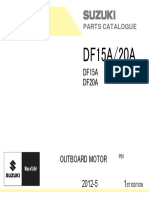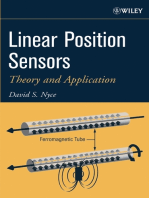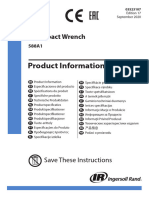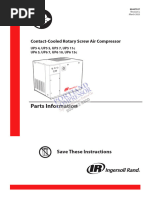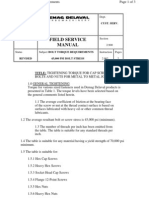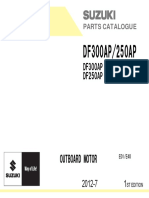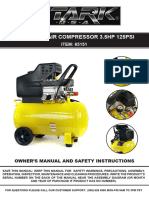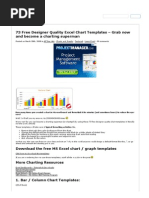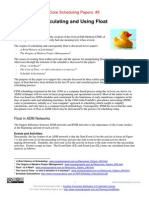TASD 8 Book
TASD 8 Book
Uploaded by
Jonathan TejedaCopyright:
Available Formats
TASD 8 Book
TASD 8 Book
Uploaded by
Jonathan TejedaCopyright
Available Formats
Share this document
Did you find this document useful?
Is this content inappropriate?
Copyright:
Available Formats
TASD 8 Book
TASD 8 Book
Uploaded by
Jonathan TejedaCopyright:
Available Formats
Operating Manual
for a
TASD 8
Screen Changer with
integrated divert boring
Trendelkamp Order No.: 20035354
Customer: GALA INDURSTRIES INC.
P.O. R0140445
Date: October 2003
Trendelkamp Technologie GmbH
Administration: Bahnhofstraße 43
D-48356 Nordwalde
Phone: +49-2573/925-0
Fax: +49-2573/925-25
Internet: www.trendelkamp.com
E-Mail : trendelkamp@trendelkamp.com
Operating Instructions
Screen Changer with integrated divert boring
2/45
Order-Number
20035354 Typ TASD 8
TABLE OF CONTENTS
Chapter 1. General Notes
Chapter 2. Technical Data
Chapter 3. Design and operation
Chapter 4. Safety
Chapter 5. Transport, Storage and Conservation
Chapter 6. Installation
Chapter 7. Initial Run /Operation
Chapter 8. Maintenance and Repair
Chapter 9. Elimination of faults
Chapter 10. Spare
Append ix 1 Declaration of Conformity
Appendix 2 Electrical documentation
Appendix 3 Hydraulic unit
Appendix 4 Local distributer list- Lubrication suppliers
Appendix 5 Dimension sheet
Date: October 2003
Operating Instructions
Screen Changer with integrated divert boring
3/45
Order-Number
20035354 Typ TASD 8
1. General Notes
INTRODUCTION
We assume that sufficient knowledge of hydraulic and electrical control engineering is available at
the user or operator of the TRENDELKAMP screen changer to assess safety issues and control errors.
USE
The TRENDELKAMP screen changer valve serves to divert plastic melt within an extrusion system.
COPYRIGHT
All copyrights in these Operating Instructions remain the property of Trendelkamp Technologie
GmbH.
These Operating Instructions are intended for the user and the user's personnel only. The instructions
and notes contained in it may neither in full or in part be:
copied
distributed, or
disclosed in any other way.
Any contravention is liable to criminal prosecution!
Date: October 2003
Operating Instructions
Screen Changer with integrated divert boring
4/45
Order-Number
20035354 Typ TASD 8
TABLE OF CONTENTS
2.1 Data sheet
2.2 Tightening torques of adapter screws
2.3 Lubricants
2.3.1 Lubricant for the Diverter Valve Bolt
2.3.2 Castrol address
Date: October 2003
Operating Instructions
Screen Changer with integrated divert boring
5/45
Order-Number
20035354 Typ TASD 8
2. Technical Data
2.1 Data sheet
Item Designation Data
No.
1. Type TASD 8
2. Year of manufacture 2003
3. Order No. 20035354
4. Dimensions mm LxWxH 2751 x 470 x 954
5. Extrusion height mm ----
6. Weight Kg approx. 1111
7. Screens Quantity 1
7.1 Screen Area Cm ² 540
7.2 Screen Dimensions mm 192 (+0,5) x280 (-0,5)
7.3 Throughput Kg/hr 4400
8. Heating
8.1 Capacity of cartridges W 10x 1250W
8.2 Type of cartridge Manufacturer Gebhard/HLP
8.3 Voltage V / Hz 230V / 50Hz
10. Hydraulic cylinders
10.1 Cylinder identification Type 160 x 100 x 440
10.2 Cylinder position In melt-flow left position
11. Contol systems
11.1 temperature sensor bores size M12; 15/30 deep
11.2 Melt temper. sensor boring size ½” –20UNF-2B
11.3 Melt pressure sensor borin. size ½” –20UNF-2B
Date: October 2003
Operating Instructions
Screen Changer with integrated divert boring
6/45
Order-Number
20035354 Typ TASD 8
2.2 Tightening torques of adapter screws
Please refer also to Operating Instructions, chapter 6 "Assembly".
THREAD TIGHTENING TORQUES MA (NM)
WITH STRENGTH CLASS:
Metric Inch 8.8 10.9
M10 3/8" 25 35
M12 1/2" 45 65
M16 5/8" 105 155
M20 3/4" 215 305
M24 7/8" 365 525
M30 1 1/2" 725 1020
M36 1 1/2" 1225 1725
Date: October 2003
Operating Instructions
Screen Changer with integrated divert boring
7/45
Order-Number
20035354 Typ TASD 8
2.3 Lubicants
2.3.1 Lubricant for the Diverter Valve Bolt
For lubricating the bolt any highly concentrated molybdenum sulphide lubricating paste or spray may
be used. Do not use silicone or organic lubricants.
Heat resistance to at least 450ºC.
Recommendation:
Mollub Alloy TopFit 3844: see 2.3.2
MoS2 - spray paste: Molyplex RH 20
Supplier: Rhenus Chemie Mönchengladbach
2.3.1 Castrol address
Castrol Industrial North America Inc.
1100 West 31st Street
Downers Grove, IL 60515
USA
Phone: 630 241 4000
Fax: 630 241 0930
Date: October 2003
Operating Instructions
Screen Changer with integrated divert boring
8/45
Order-Number
20035354 Typ TASD 8
Table of Contents
3 Design and operation
3.1 Constructional Design
3.2 Function
3.3 Changing the screens
3.4 When is a change of the screens required?
3.5 Operating, Monitoring and Safety Devices
Date: October 2003
Operating Instructions
Screen Changer with integrated divert boring
9/45
Order-Number
20035354 Typ TASD 8
3. Design and operation
3.1 Constructional Design
TASD - Diverter Valve and Screen Changer Unit
fig. 3.1
The Diverter Valve and Screen Changer Unit consists of the housing (1) and a screen bolt (2),
moveable at left angles to the melt flow. The bolt is equipped additionally with a diverter valve
boring. The screen bolt is moved by a hydraulic cylinder (3). The hydraulic unit (not showend) is
connected to the cylinder by tubes. The screen bolt has one opening for installing a screen as well as a
start-up channel. Filters made of one or several layers of rectangular wire screen are put into the
screen openings. The outer sealing of the screen chamber is guaranteed by the snug fit of the bolt in
the housing. The unit is heated electrically by heating cartridges and can be equipped with
temperature sensing elements to control the temperature. Safety hoods (5,6) prevent contact with the
movable parts of the Diverter Valve and Screen Changer Unit. The unit is mounted on a base plate
(7).
Date: October 2003
Operating Instructions
Screen Changer with integrated divert boring
10/45
Order-Number
20035354 Typ TASD 8
3.2 Function
fig. 3.2
The valve bolt can be shifted in the housing by means of a hydraulic cylinder. The production
position (B) and the diverting position (A) of the bolt are determined by the limits switches at the
ends of travel of t he piston in the hydraulic cylinder.In the discontinuous screening process, the flow
of molten plastic is led through a channel a screening chamber after entering the screen changer
housing. The screen are supported by a screen support plate within the bolt.
The high speed of the valve bolt permits a diversion of the melt without an interruption in the
production.
The production bore can be cleaned in diverting position (A).
Date: October 2003
Operating Instructions
Screen Changer with integrated divert boring
11/45
Order-Number
20035354 Typ TASD 8
3.3 Changing the screens
Attention: Wear protective gloves and clothing when changing the screens!!
a) Change position
In the change position the clogged screens (2) can be removed from the screen opening
(3) and replaced by new ones (4). With a suitable tool (5) the screens can be taken at the
removal groove (6) and lifted. The screen opening should be cleaned before new screens
are inserted. A copper spattle, for example, is suitable. For removing deposits that do not
come off easily wire brushes can be used. The new screens are held in their position by
the shoulders of the screen opening.
Attention: It is important that the screens will immediately be changed and the bolt be
cleaned after moving the screen bolt. Only screens with the required dimensions
should be used.
Loose parts of the screens are to be removed before the screens are inserted into the
screen openings.
fig. 3.3
Date: October 2003
Operating Instructions
Screen Changer with integrated divert boring
12/45
Order-Number
20035354 Typ TASD 8
3.4 When is a change of the screens required?
The time of exposure of the screens depends on the amount of impurities in the processed melt.
It is necessary to change the screens if:
- the pressure between the extruder and the screen changer rises
- the output is reduced
- the drive of the extruder consumes more power
- the extruder temperature rises due to friction
Warning:
It is recommended to clean or replace the screens before the maximum pressure difference of
is reached. A justifiable difference in pressure is to be determined by trial.
It depends on:
- required product quality
- necessary fineness of mesh
- viscosity and level of impurities of the melt
Date: October 2003
Operating Instructions
Screen Changer with integrated divert boring
13/45
Order-Number
20035354 Typ TASD 8
3.5 Operating, Monitoring and Safety Device
1. PROTECTIVE COVERS
The area of the valve bolt displacement between housing and cylinder plate is covered with a guard
plate. This cover can be removed for maintenance work.
2. VALVE BOLT FINAL POSITION MONITORING
The final positions of the valve bolt (production and diverting position) are monitored by limit
switches.
3. HEATING CONTROL / MONITORING
Normally one control system is provided for the screen changer and additional control systems,
identified by corresponding temperature sensor bores, are provided for heated adapters. Please refer
also to chapter 2 "Technical Data".
Attention: If no cartridge heater monitoring is installed, the current conduction in the cartridge
heaters must be checked regularly with an ammeter.
Do not operate the screen changer with defective cartridge heaters!
4. MELT PRESSURE / MELT TEMPERATURE MONITORING
Bores for corresponding measurement instruments can be provided in the housing of the screen
changer. Please refer also to chapter 2 "Technical Data".
Date: October 2003
Operating Instructions
Screen Changer with integrated divert boring
14/45
Order-Number
20035354 Typ TASD 8
TABLE OF CONTENTS
4.1 Proper application
4.2 Indication of danger
4.3 Safety devices
4.4 Safety precautions for changing the screens
4.5 Safety precautions for the maintenance
4.6 Remaining dangers
Date: October 2003
Operating Instructions
Screen Changer with integrated divert boring
15/45
Order-Number
20035354 Typ TASD 8
4. Safety
4.1 Proper application
The Diverter Valve and Screen Changer Unit is to be used for the continuous filtration of
thermoplastics in the melt flow between the extruder and the following unit or tool (e.g. granulation).
Furthermore the unit can fulfil the function of a diverter valve. The Diverter Valve and Screen
Changer Unit is not designed for any other range of application.
4.2 Indication of danger
The following signs are on the Diverter Valve and Screen Changer Unit
Danger of being burned
Wear safety gloves!
Switch off current before
opening the terminal box
Date: October 2003
Operating Instructions
Screen Changer with integrated divert boring
16/45
Order-Number
20035354 Typ TASD 8
4.3 Safety devices
All areas of danger, which could not be avoided for constructional reasons, are equipped with
moveable safety hoods where necessary to insure safe use of the unit (fig. 4.3).
The safety hood (1) on the operator’s side of the screen changer is moveabel in order to ease changing
the screens. The lever pushed to unlock the safety hood activate a contact switch (2), which shuts
down the hydraulic system immediately. This is to prevent unintentional movement of the screen
bolts when the safety hood is open. A positive result is an immense reduction in the risk of being
injured, especially of being burned. Consequently, it is only possible to move the screen bolts when
the safety hood is shut properly.
The Safety device (3) between housing and hydraulic cylinders is removeable too. For removing this
safety device a tool ( inner hexagon key ) has to be used in order to remove that cover.
fig. 4
Date: October 2003
Operating Instructions
Screen Changer with integrated divert boring
17/45
Order-Number
20035354 Typ TASD 8
4.4 Safety precautions for changing screens
Due to the heating of the Diverter Valve and Screen Changer Unit housing, screens may only be
changed when wearing the corresponding safety clothing. Otherwise, unprotected parts of the body
can be burned when the screen bolts are touched.
4.5 Safety precautions for the maintenance
Before beginning the maintenance work, the complete production line is to be switched off and
disconnected from the power supply. The master switch is to be protected against being turned on
without authorisation.
Signs are to be put up that signal work on the Diverter Valve and Screen Changer:
Do not turn on!
Maintenance work
Name: .................
Date: .................
4.6 Remaining dangers
The engineers, who designed the Diverter Valve and Screen Changer Unit, endeavoured to avoid all
sources of danger. Despite all efforts the following dangers still remain:
No. Source of danger Danger Danger can be avoided by
1 Temperature of approx. -Burns -Wearing safety clothing
200 °C at the housing -Wearing safety gloves
2 Changing the screens -Burns -Wearing safety clothing
-Cuts -Wearing safety gloves
3 Assembly/Dismantling of the -Crushing parts of the -Reminding the staff constantly of the
unit body dangers
-Burns -Wearing safety clothing
-Wearing safety gloves
Date: October 2003
Operating Instructions
Screen Changer with integrated divert boring
18/45
Order-Number
20035354 Typ TASD 8
Table of Contents
5.1 Moving the unit
5.2 Storage
5.3 Preparation for storage of the unit
Date: October 2003
Operating Instructions
Screen Changer with integrated divert boring
19/45
Order-Number
20035354 Typ TASD 8
5. Transport, Storage and Conservation
5.1 Moving the unit
If the unit should be moved long distances, it must be transported by a crane or by forklift with
appropriate capacity. In order to transport the unit by crane there are eye screws (2) on the housing
and on the top of the flange plate of the hydraulic for inserting suitable lifting aids. This is advisable
to balance the unit due to the high centre of gravity. A transport frame (1), provided, can be mounted
to the screen changer (3) to provide more stability when being transported by forklift. Before
installing the screen changer, the transport frame must be removed.
fig. 5.1
Date: October 2003
Operating Instructions
Screen Changer with integrated divert boring
20/45
Order-Number
20035354 Typ TASD 8
5.2 Storage
Requirements for the storage area for packed and unpacked units
Building - weatherproof
- protected against unauthorised entry
Floor - check carrying capacity while bearing in mind the weight of the screen
changer
- free from vibrations
- firm, with water drain
- accessible for transport and lifting devices
Room conditions - well aired
- dry
Other things - the units are to stand firmly and placed where they are easily seen
- do not stack the units
5.3 Preparation for storage of the unit
Before considerable breaks in operation are taken, housing and screen bolts are to be cleaned as
described in unit 8.3 or 8.4 of chapter 8 “Maintenance and repairs”.
Remember: The screen bolts must be lubricated after cleaning! See list of suggested lubricants in
8.7. First the screen bolts are cleaned in screen changing position and lubricated.
Then they are cleaned in production position and lubricated. The two openings, intake and outtake,
in the housing must be closed with the covering plates delivered with the Diverter Valve and Screen
Changer Unit. Further steps for preparation are not necessary.
Date: October 2003
Operating Instructions
Screen Changer with integrated divert boring
21/45
Order-Number
20035354 Typ TASD 8
TABLE OF CONTENTS
6.1 Preparing for installation
6.2 Installation
Date: October 2003
Operating Instructions
Screen Changer with integrated divert boring
22/45
Order-Number
20035354 Typ TASD 8
6. Installation
6.1 Preparing for installation
a) Installation tools
The unit is basically assembled on delivery. The following tools are required for installation:
- general mechanist tools
- general electrician tools
- torque wrench
- lifting devices with a minimum lifting capacity corresponding to the Diverter Valve and Screen
Changer Unit (weight, see chapter 2 “Technical Data”)
b) Transport frame
Trendelkamp Diverter Valve and Screen Changer Units are delivered with a transport frame (fig.
5.1)(1), which is screwed tightly to the unit. This eases transport to the production line by forklift.
Before installing the Diverter Valve and Screen Changer Unit, the transport frame must be removed.
6.2 Installation
General remarks:
All flange connections are to be made with screws with property class 10.9. They should be tightened
diagonally with a torque wrench. The required torque can be read in table 2.2 Torque for screw
connections. All installation procedures must be carried out by qualified specialists!
a)The unit must stand on a suitable underground.
b) Clean the sealing surfaces with a clean cloth thoroughly (Avoid damage at all costs!)
c) Connect the Diverter Valve and Screen Changer Unit to the extruder in accordance with the melt
flow direction. If necessary, the height of the unit can be altered by adjusting spindles. The screen
changer must stand absolutely level in all directions.
d) Connect consecutive equipment to the outtake of the Diverter Valve and Screen Changer Unit.
e) Connect heating, monitoring and controlling devices in accordance with all valid safety
regulations.
f) Set up the hydraulic unit and connect it to the control system (see connection plan app. 3 ).
g) Install the hydraulic tubes included.
h) Connect and if necessary adjust the inductive switches (see appendix 4).
Date: October 2003
Operating Instructions
Screen Changer with integrated divert boring
23/45
Order-Number
20035354 Typ TASD 8
TABLE OF CONTENTS
7.1 Before starting operation
7.2 Initial operation
Date: October 2003
Operating Instructions
Screen Changer with integrated divert boring
24/45
Order-Number
20035354 Typ TASD 8
7. Initial Run /Operation
7.1 Before starting operation
Before start-up, the accessible part of the screen bolts must be checked for mechanical damage and
dirt and must be cleaned off as carefully as possible. Do not use any oils, solvents or sharp metal
objects for cleaning. Lubricate the surface of the screen bolts outside the housing according to the
lubrication plan in chapter 8.6.
Attention: When the Diverter Valve and Screen Changer Unit is put into operation without
melt the entire surface of the bolts must be coated with an even layer of lubricant!
7.2 Initial operation
a) Heat device up to working temperature. Depending on the working temperature, the time required
for heating the unit up to the required temperature is approx. 90 – 120 minutes. When the required
temperature is reached, a period of approx. 30 minutes has to expire before production can be started,
in order to heat the screen changer evenly.
Attention: The working temperature must be controlled by a temperature sensing element and must
not exceed 400 °C! The temperature set for the housing and the attached parts (flanges, adapters,
etc.) must be the same to ensure even heating of the product. For reasons of process engineering,
the temperature of the screen changer housing must be adjusted to approx. 20°C above the
melt temperature.
b) Put screen packs neatly on the screen support plates.
c) Move the bolt into the start-up position (see 3.4), this is the defined basic position of the Diverter
Valve and Screen Changer Unit, by actuating the selector switch (fig. 9.2)(7)
d) Start extruder, turn on accessory devices.
Date: October 2003
Operating Instructions
Screen Changer with integrated divert boring
25/45
Order-Number
20035354 Typ TASD 8
TABLE OF CONTENTS
8.1 General things
8.2 Maintenance during the first hours of operation
8.3 Maintenance after a considerable period of operation
8.4 Maintenance after several years of operation
8.4.1 Dismantling of the screen bolt
8.4.2 Cleaning the screen changer unit
8.4.3 Installation of the cleaned screen bolt
8.5 Heating device
8.6 Table of lubricants
8.7 Recommendation of lubricants
Date: October 2003
Operating Instructions
Screen Changer with integrated divert boring
26/45
Order-Number
20035354 Typ TASD 8
8. Maintenance and repairs
8.1 General things
If the following service instructions are complied with, trouble-free operation can be guaranteed.
An elastic synthetic film offers optimal lubrication for the surfaces of the screen bolt. This will keep
the device service-free between cleaning intervals.
8.2 Maintenance during the first hours of operation
The surface of the screen bolts is to be maintained carefully and to be covered with a thin layer of one
of the lubricants listed under 8.7.1-4.
WARNING: The lubricant may not enter the screen openings of the bolt..
8.3 Maintenance after a considerable period of operation
Dust, lubricants and hardened material can form deposits on the bolt parts outside the housing, which
can hinder the movement of the bolts. When this happens, remove the deposits carefully. The bolts
should be cleaned with a copper wire brush, copper braiding or an emery belt with a grain size of no
less than 180. After cleaning the bolt, grease it with a thin layer of one of the lubricants mentioned
under 8.7.1-4.
8.4 Maintenance after several years of operation
Recommendation: This maintenance work shoud be carried out by the Trendelkamp Customer
Service (Phone +49-2573-925-0, Fax +49-2573-925-25).
Attention: The maintenance work described in 8.4.1-8.4.3 should be carried out by accordingly
qualified experts.
Date: October 2003
Operating Instructions
Screen Changer with integrated divert boring
27/45
Order-Number
20035354 Typ TASD 8
8.4.1 Dismantling of the screen bolt
- Remove the rear protection cover by loosening the screws
- Bridge the limit switch (2) ( fig. 6), as available, to make the hydraulic unit function in
spite of the open protection cover
- Drive the bolt into screen changing position
- Turn off the hydraulic unit and protect it against being switched on unauthorisedly.
- Mark the position of bolt guiding (fig9) (1) to the outer limit flange (2)
- Loosen the hexagon screws (3) which fix the bolt guiding
- After removing the bolt guiding, loosen the interior hexagon screws (4)
- Attention: Do not move the inner limit flange (5) or the nut (6)
- dismount hydraulic cylinder
fig. 9
- Push out the piston to the using a suitable pin and a corresponding hydraulic or mechanical press.
Date: October 2003
Operating Instructions
Screen Changer with integrated divert boring
28/45
Order-Number
20035354 Typ TASD 8
8.4.2 Cleaning the screen changer unit
Disk brushes with the same diameter as the boring that is to be cleaned are suitable for a thorough
cleaning of the borings of the screen changer housing. Right angle grinder round brushes are suitable
for cleaning the surface of the bolt, while pencil brushes are suitable for the screen openings. The
loosened connection elements should be cleaned, too, to facilitate an easy assembly.
Polished fit surfaces (surface of the screen bolt/boring in the housing for installing the screen bolt)
always have to be cleaned with brass brushes!
The wire of the used brushes has to be „plaited“. The indicated maximum number of revolutions of
the brush may not be exceeded by the driving tool.
Deposits on the surface of the bolt and in the boring, that also contain rests of lubricants, should be
cleaned with e.g. petroleum before being treated with brushes in order to avoid a contamination of the
brushes with lubricants. The applied solvent has to be removed completely before the cleaning with
brushes and the commissioning of the screen changer!
Date: October 2003
Operating Instructions
Screen Changer with integrated divert boring
29/45
Order-Number
20035354 Typ TASD 8
8.4.3 Installation of the cleaned screen bolt
- Apply a layer of one of the lubricants listed under 8.7.1-8.7.4 to the screen bolt and the
boring within the housing.
- Put the bolt into the housing while heeding the marks on the front part. Attention: The bolt
may get jammed in the housing (see 8.4.1).
- Fit hydraulic cylinder
- Drive the piston rod into a middle position between housing and hydraulic cylinder.
- Affix the outer limit flange to the screen bolt
- Affix the bolt guiding to the outer limit flange while heeding the marks. Twisting the screen
bolt in the holes of the bolt guiding must remain possible.
- Drive the bolt into the housing.
- Turn off the hydraulic unit and protect it against being switched on without authorisation.
- Control the connection (fig. 10) between the outlet opening of the screen bolt (1) and the
outlet channel (2). The connection must be free of noticeable edges.
- If necessary, the screen bolt must be twisted until the connection is smooth.
- If the inner limit flange has been moved on dismantling the bolts, the bolt may have to be
adjusted lengthwise as well. In order to do this, the nut (6) (fig. 9) has to be loosened in
order to twist the inner limit flange (5) (fig. 9) lengthwise on the piston rod.
- After controlling and adjusting the connection carefully, the bolt guiding can be fixed.
fig. 10
Date: October 2003
Operating Instructions
Screen Changer with integrated divert boring
30/45
Order-Number
20035354 Typ TASD 8
8.5 Heating device
The screen changer is heated by high-capacity heating cartridges (R1-R10, fig 11) within the housing.
Their feed wires run through channels in the housing or below covers and meet in the connector box.
For inserting a thermocouple there are borings at the top and bottom of the housing.
If the heating cartridges are defective, they can be pushed out of the housing with a bolt (dia. 19.5-
19.8 mm) after the cover plate has been removed. New cartridges may be inserted only into cleaned
borings and only if they have been treated with a temperature-proof lubricant.
Check heater function after ten minutes of heating with new heating cartridges and check the flowing
of current at each replaced heating cartridge by measuring.
Attention: For reasons of process engineering, the temperature of the screen changer housing must be
set at approx. 10-20°C above the melt temperature. The temperature set for the housing and the
attached parts (flanges, adapters, etc.) must be the same to ensure even heating of the product and to
prevent errors in production.
Fig.11
Date: October 2003
Operating Instructions
Screen Changer with integrated divert boring
31/45
Order-Number
20035354 Typ TASD 8
8.6 Table of lubricants
Pos lubrication area lubricant amount- Interval
1. front area of bolt Molybdenum sulphide 10 g when necessary,
* recommended after 5-10
screen changes
3. rear area of bolt Molybdenum sulphide 10 g when necessary,
* recommended after 5-10
screen changes
* see 8.7 recommendation of lubricants
Fig.12
Date: October 2003
Operating Instructions
Screen Changer with integrated divert boring
32/45
Order-Number
20035354 Typ TASD 8
8.7 Recommendation of lubricants
Every lubricant, whether as spray or paste, that contains a high concentration of molybdenum
sulphide can be used. Do nor use organic lubricants or lubricants containing silicone to grease the
device.
Requirements of the lubricants: temperature stability of at least up to 450 °C (800 °F).
pressure stability VKA test: 4000 N
coefficient of friction SRV test: 0.14
Suppliers:
8.7.1 Mollub Alloy TopFit 3844 : for local Tribol adresses see Appendix 5
8.7.2 Klüber TOP-Paste – No. 089 003 : for local Klüber adresses see Appendix 5
Klüber Wolfrakote SSP-No. 120 102 : for local Klüber adresses see Appendix 5
8.7.3 MoS2-spray paste : Molyplex RH20
Supplier: Rhenus Chemie, Mönchengladbach
8.7.4 Solid paste : Molykote G-Rapid
Supplier: Dow Corning GmbH, München
8.7.5 Assembly paste and spray : Anti Seize
Supplier:Gleitmolybdän-Schmierstoffe,
München
8.7.6 Assembly spray : Weicon Anti-Seize
Supplier:P.W.Weidling & Sohn GmbH&Co.KG,
Münster
Phone:+49-0251/32061 Fax:+49-0251/32064
Date: October 2003
Operating Instructions
Screen Changer with integrated divert boring
33/45
Order-Number
20035354 Typ TASD 8
9. Elimination of faults
Fault Possible Causes Measure
Bolt cannot be driven out of or into Hydraulic unit does not Check hydraulic system
the housing deliver/hydraulic pressure does not See operating manual (appendix)
build up
Friction at the bolt surface due to Cleaning/lubrication see chapter 8.
covering with dirt or insufficient If necessary, raise working pressure
lubrication of hydraulic unit for a short time
Safety cover not correctly closed against closing of safety cover
Leakage of screen changer Sliding (sealing) surface damaged Notify Trendelkamp customer
service
Working temperature is not reached Heating not/wrongly connected Check connection
Damaged heating cartridges Check, if necessary change
cartridges
Heating control damaged/wrongly Check heating control
adjusted (Heating control is not
included in the scope of supply)
Date: October 2003
Operating Instructions
Screen Changer with integrated divert boring
34/45
Order-Number
20035354 Typ TASD 8
10. Spare parts
10.1 Supply of spare parts
We give a guarantee only for the original spare parts supplied by us. If other spare parts are installed,
Trendelkamp GmbH & Co.KG does not give any warranty.
Spare parts and customer service:
Trendelkamp
Technologie GmbH.
Bahnhofstraße 39 - 43
D-48356 Nordwalde
Phone: +49-2573/925-0
Fax: +49-2573/925-2
10.2 Table of spare parts for the screen changer
Item Designation Qty.. Order code/tech. designation.
1 Housing 1 535413
2 Diverter bolt 1 738036
3 Screen support plate 1 718360
4 Cover plate (inlet) 1 535437
5 Insulating plate (inlet) 1 535440
6 Cover plate (top) 1 535435
7 Cover plate (bottom) 1 535436
8 Insulating plate (top) 1 535438
9 Insulating plate (bottom) 1 535439
10 Polymer chute 1 535441
11 Gasket left (Cable channel) 1 535444
12 Gasket right (Cable channel) 1 535445
13 Cover plate left (Cable channel) 1 535442
14 Cover plate right (Cable channel) 1 535443
15 Counter nut 1 718013 A
16 Limit flange (outer) 1 738038
17 Limit flange (inner) 718012 C
18 Distance bolt 4 738037
19 Bolt guide 1 738039
20 Fixing screw – Screen support plate 1 738040
21 Hydraulic cylinder 1 742554
22 Heating cardridge 10 743101
23 Hydraulic hose 2 535420 (2x 4000mm)
24 Safety cover (rear) 1 535446
25 Linear set for safety cover (front) 2 HG45; L=500mm (Hegra Company)
26 Pane 2 738046
27 Proximity switches – activator 1 743082
28 Proximity switches 1 743081
29 Threaded elbow flange joint (installed at 2 WFS 65/30-PS
hydraulics aggregate)
30 Switching amplifier (loses added) 2 743026
Date: October 2003
Operating Instructions
Screen Changer with integrated divert boring
35/45
Order-Number
20035354 Typ TASD 8
fig. 13 Spare parts for screen changer
Date: October 2003
Operating Instructions
Screen Changer with integrated divert boring
36/45
Order-Number
20035354 Typ TASD 8
10.3 Table of spare parts for the hydraulic cylinder
Item Designation Qty. Order code/tech. description
1 Complete cylinder 2 Complete cylinder TASD 8
2 Piston 2 Piston TASD 8
3 Piston rod 2 Piston rod TASD 8
4 Seal kit 2 Seal kit TASD 8
R 1/2“
fig. 14, Spare parts for the hydraulic cylinder
Date: October 2003
Operating Instructions
Screen Changer with integrated divert boring
37/45
Order-Number
20035354 Typ TASD 8
Appendix 1 Declaration of Conformity
EC Declaration of Conformity
according to the machinery guideline 98/37/EG, Appendix II A
We, Trendelkamp
Technologie GmbH,
hereby declare that the machine as detailed below fulfils the basic safety and health regulations of the EC
guidelines due to its design and construction as well as in the model put into circulation by us. If the machine is
altered without our consent, this declaration becomes invalid.
Designation of the machine: Screen Changer with integrated divert boring
Type: TASD 8
Machine No.: 20035354
Appropriate
EC guidelines: EC Machinery guideline (98/37/EG)
EC Low voltage guideline (73/23/EWG)
EC guideline Electromagnetic compatibility (89/336/EWG)
i.d.F. 93/31/EWG
Applied harmonised
standards, especially: DIN EN 292 Part 1 and Part 2
DIN EN 349
DIN EN 60204 Part 1
Date/Signature of manufacturer: ........................................................................
Details of the signatory: Managing Director
Date: October 2003
Operating Instructions
Screen Changer with integrated divert boring
38/45
Order-Number
20035354 Typ TASD 8
Appendix 2 Elektrical documentation
Date: October 2003
Operating Instructions
Screen Changer with integrated divert boring
39/45
Order-Number
20035354 Typ TASD 8
Appendix 3 Hydraulic documentation
1. Hydraulic cylinders
It is necessary to take care that the cylinder rod is not damaged in order to guarantee a long life for the
screen changer. Damage to the rod could lead to leakage.
Changing the seals
1) Loosen and unscrew the counternut (1).
2) Unscrew the guide bush (2).
3) Pull the piston rod with the pistons (3 and 4) out of the pipe.
4) Remove the seals (5 and 6) with a blunt screw driver.
5) Install new seals. Attention, do not damage the seal edges.
6) Reassemble the cylinder in reverse order.
7) Adjust the travel exactly by turning the guide bush
8) Check by pressure test whether the seals are o.k.
Attention: Make sure that everything is absolutely clean when changing the seals.
R 1/2“
fig. 15
Date: October 2003
Operating Instructions
Screen Changer with integrated divert boring
40/45
Order-Number
20035354 Typ TASD 8
2. Hydraulic unit
Hydraulic unit is equipped with a bubble storage for operation of the TASD Screen Changers with a
high speed for bolt movement.
Control elements:
Y1 – (magnetic solenoid valve) deflation of the bubble storage (secruity)
Y2 – (magnetic solenoid valve) moving the screen bolt
Y3 – (magnetic solenoid valve) preparing moving of the screen bolt in produktion position
Y4 – (magnetic solenoid valve) preparing moving of the screen bolt in start-up position
S1 / S2 – level switch with temperature contact (secruity)
S3 – pressure switch 280 bar (pressure rising)
S4 – pressure switch 180 bar (pressure falling)
Description of the hydraulic unit (fig3.1 / 3.2):
The pump of the hydraulic unit transports the oil through the P-Lines to the bubble storage.
Pressure switches (S4 / S3) control the pressure in this line. If the pressure reaches more than 280 bar,
S3 give a signal: “Pump Stop”. The oil transport is interrupted.
If now, after the pressure is developed in the bubble storage, the bolt should be driven e.g. into Start-
Up position, the magnetic solenoid valve Y4 must be operated. With this the outlet A from the unit
would be prepared for moving the cylinder in Start-Up positions.
Now the magnetic solenoid valve Y2 have to be operated for moving the hydraulic cylinder. The oil
flows through outlet A to the cylinder. The moving of the cylinder effected so long time until the
final position is reached and an initiator gives a signal: "Y2 switch off".
For moving the bolt into Production position the magnetic solenoid valve Y3 have to be switched.
Now the outlet B would be prepared for using as a pressure line. The moving of the cylinder take
place only by operating the magnetic solenoid valve Y2 too exactly according to the same principle as
by the moving into the Start-Up position.
By moving the bolt, the pressure in the bubble storage falls. If the pressure sinks under
180 bar, the pressure switch S4 gives a signal: „Pumpe Start“. The oil transport begins again until the
pressure would exceeded 280 bar and S3 a signal gives: „Pump Stop“(s.a.).
Date: October 2003
Operating Instructions
Screen Changer with integrated divert boring
41/45
Order-Number
20035354 Typ TASD 8
Emptying of the bubble storage: The emptying of the bubble storagecan
be made by three different ways:
1. During the operating of the hydraulic aggregate, if a pressure in
the bubble storage is reached by more than 330 bar, then a pressure control valve
ensures for the fact that the pressure is diminished, as the oil
is led from the bubble storage to the hydraulic tank.
2. The emptying can be made also over a hand valve. With operating the appropriate line is
switched free and the oil can flow over this line to the hydraulic tank.
3. The third way is the emptying done by the magnetic solenoid valve Y1. With switched off
aggregate Y1 is not operated and thus to flow switched. The oil from the bubble storage
flows in the tank. Y1 is thus a safety valve, which ensures that the bubble storage is
pressure-free by non-operation and e.g. maintenance work can safely be realized.
For further security two switches (S1 /S2) are attached at the hydraulic tank.
S1 controls the oil level in the tank. If this is too low, a signal passed on which the operation of the
hydraulic aggregate interrupted.
S2 controlles the temperature of the hydraulic oil. If the oil reaches a temperature of over 70°C, a
signal is passed on also here, which the operation of the hydraulic aggregate interrupted.
Date: October 2003
Operating Instructions
Screen Changer with integrated divert boring
42/45
Order-Number
20035354 Typ TASD 8
fig.3.1 Hydraulic connection diagram TASD
Date: October 2003
Operating Instructions
Screen Changer with integrated divert boring
43/45
Order-Number
20035354 Typ TASD 8
fig.. 3.2 Hydraulic unit TASD
Date: October 2003
Operating Instructions
Screen Changer with integrated divert boring
44/45
Order-Number
20035354 Typ TASD 8
Appendix 4 Local distributer list- Lubrication suppliers
Tribol
Castrol Industrial North America INC.
1100 West 31st Street
Downers Grove,IL 60515
USA
Phone: 6302414000
Fax: 6302410930
Klüber Lubrication
Klüber Lubrications North America L.P.
Southeastern Group Office
SC 29601 Greenville
233 North Main St
Phone: 8008894283
Fax: 8644670740
Date: October 2003
Operating Instructions
Screen Changer with integrated divert boring
45/45
Order-Number
20035354 Typ TASD 8
Appendix 5 Dimension sheet
Date: October 2003
You might also like
- Coduri Eroare Claas AxionDocument234 pagesCoduri Eroare Claas AxionAsavei Mihăiță100% (1)
- John Deere X320 User ManualDocument1 pageJohn Deere X320 User Manualbvanwynsberghe58No ratings yet
- JUPITER2200-01 1233-SA EngDocument189 pagesJUPITER2200-01 1233-SA EngZdenko Nagy100% (2)
- Bridgeport Series 2 Interact 2 Milling MachineDocument95 pagesBridgeport Series 2 Interact 2 Milling MachineJaroslav Acs100% (2)
- Df15a - 20a PDFDocument66 pagesDf15a - 20a PDFJonathan Alexander Rojas BlancoNo ratings yet
- JCB 1CX PDFDocument80 pagesJCB 1CX PDFAndré LuisNo ratings yet
- Type CraneDocument108 pagesType CraneIndra RustiawanNo ratings yet
- Kelly - DE EN - 905 518 1Document18 pagesKelly - DE EN - 905 518 1JORGE BARRERA100% (2)
- Arquitectura BritanicaDocument306 pagesArquitectura BritanicaErmitañoDelValle100% (2)
- Netapp Interview Questions Q A PDFDocument12 pagesNetapp Interview Questions Q A PDFAmul VermaNo ratings yet
- ACE TutorialDocument159 pagesACE TutorialMostafa AhmedNo ratings yet
- Rease SystemDocument82 pagesRease Systemsundya100% (1)
- SP350VS非液压软管总成扣压机 sp350Document14 pagesSP350VS非液压软管总成扣压机 sp350walk666No ratings yet
- Generator Bearing ServiceDocument10 pagesGenerator Bearing ServiceMustafa A.W100% (1)
- AugerDocument26 pagesAugerbilly_bNo ratings yet
- Pms83eng 030605Document20 pagesPms83eng 030605Krzysztof PiątekNo ratings yet
- 2.0 User Manual Ipswiss Nr. 1011299Document35 pages2.0 User Manual Ipswiss Nr. 1011299TroubleshootingNo ratings yet
- Operating Instructions Varistor Module Dk4: Pintsch Bamag Antriebs-Und Verkehrstechnik GMBHDocument11 pagesOperating Instructions Varistor Module Dk4: Pintsch Bamag Antriebs-Und Verkehrstechnik GMBHArtemy KhotenovNo ratings yet
- Guidelines for 3600 turbochargerDocument15 pagesGuidelines for 3600 turbochargerromanoff.74No ratings yet
- Product Information: Air Impact WrenchDocument56 pagesProduct Information: Air Impact WrenchAtul PandeyNo ratings yet
- Engine Complete 4Document41 pagesEngine Complete 4Garcia CruzNo ratings yet
- D-75 Parts R2Document37 pagesD-75 Parts R2naokito AkemiNo ratings yet
- ML 82 Phase 7 Microprocessor With FSS Options PN 450568Document37 pagesML 82 Phase 7 Microprocessor With FSS Options PN 450568Miguel IralaNo ratings yet
- WIKA - FlOW SWITCHDocument4 pagesWIKA - FlOW SWITCHuday245No ratings yet
- X354 With 42" Accel Deep™ Deck: Maintenance Reminder SheetDocument1 pageX354 With 42" Accel Deep™ Deck: Maintenance Reminder SheetFlorin TomaNo ratings yet
- JCB 3CX 4 S MasterDocument24 pagesJCB 3CX 4 S MasterManuals Catalogs100% (2)
- Si946 DV4Document11 pagesSi946 DV4Mahmoud El-abdNo ratings yet
- UP6!5!15C Parts ManualDocument124 pagesUP6!5!15C Parts ManualrikisebNo ratings yet
- Field Service Manual: Title: Tightening Torque For Cap ScrewsDocument3 pagesField Service Manual: Title: Tightening Torque For Cap ScrewsPuchit Spk100% (1)
- Product InformationDocument56 pagesProduct InformationJose Enrique Mendoza RodriguezNo ratings yet
- FB MaintSheet X300 42EdgedeckLawnTractor PDFDocument1 pageFB MaintSheet X300 42EdgedeckLawnTractor PDFRick EstellNo ratings yet
- Heavy-Duty Engine Repair Stand: Form No. 100300Document4 pagesHeavy-Duty Engine Repair Stand: Form No. 100300Kamil KováčNo ratings yet
- TMTW Orbital Motor Repair InstructionDocument24 pagesTMTW Orbital Motor Repair InstructionServicio TLMNo ratings yet
- Parts Catalog: 25, 30 HP (521cc) 2 Stroke ModelsDocument32 pagesParts Catalog: 25, 30 HP (521cc) 2 Stroke ModelsRonei MartinsNo ratings yet
- AscensorDocument24 pagesAscensorBlass Hernández Castro100% (2)
- Sigma2 5manualDocument55 pagesSigma2 5manualagnaldo de souza MaloNo ratings yet
- Low Profile Vibrating Screen 8X20Document14 pagesLow Profile Vibrating Screen 8X20VladimirNo ratings yet
- D75 Parts Manual: More User Manuals OnDocument41 pagesD75 Parts Manual: More User Manuals OnPercy de la cruzNo ratings yet
- Grundfosliterature 79781Document12 pagesGrundfosliterature 79781Wojtek MateńkaNo ratings yet
- 4 TP, TPE, TPD, TPED Series 300 Service InstructionDocument10 pages4 TP, TPE, TPD, TPED Series 300 Service InstructionKareem HelalNo ratings yet
- Pioneer Deh-2330r, 2300RB, 2300RDocument63 pagesPioneer Deh-2330r, 2300RB, 2300REdinilson BrazNo ratings yet
- Parts JCB Js160lcDocument2,073 pagesParts JCB Js160lcAdriano SilvaNo ratings yet
- DF250A 300A SuzukiDocument128 pagesDF250A 300A SuzukiWidhana FajarNo ratings yet
- Service and Parts Manual Rexel Shredder 1350 3250 Heavy Duty PDFDocument50 pagesService and Parts Manual Rexel Shredder 1350 3250 Heavy Duty PDFTonyandAnthonyNo ratings yet
- INTERSCHALT Maritime Systems AG - BluetrackerDocument29 pagesINTERSCHALT Maritime Systems AG - BluetrackerВеталь ГерасимчукNo ratings yet
- Bench Test Procedure For A R2900G and R3000H Load Haul Dump TransmissionDocument18 pagesBench Test Procedure For A R2900G and R3000H Load Haul Dump TransmissionNELSON ASENJONo ratings yet
- Deadline Anchor Operation & Maintenance ManualDocument8 pagesDeadline Anchor Operation & Maintenance ManualAndriamifidy RazafyNo ratings yet
- SERVICEDocument302 pagesSERVICEJUAN MOTABANNo ratings yet
- 8 Parts and Diagrams: This Chapter Contains Information About The Following TopicsDocument86 pages8 Parts and Diagrams: This Chapter Contains Information About The Following TopicsOFBA srlNo ratings yet
- Hustler 933424EXDocument84 pagesHustler 933424EXm.kurtsev1No ratings yet
- PM 3 002348 en 01Document28 pagesPM 3 002348 en 01wilderness_666100% (1)
- Unbrako Catalog FastenerDocument26 pagesUnbrako Catalog Fastenerdesign_rajeev100% (2)
- Parts Catalogue: ST EditionDocument30 pagesParts Catalogue: ST EditionBecker DidierNo ratings yet
- 938g II Wheel Loader Phn00001-Up (Machine) Powered by 3126b Engine (Sebp3491 - 61) - Systems & ComponentsDocument5 pages938g II Wheel Loader Phn00001-Up (Machine) Powered by 3126b Engine (Sebp3491 - 61) - Systems & ComponentsibrahemNo ratings yet
- Super 50 Parts 450302Document47 pagesSuper 50 Parts 450302naokito AkemiNo ratings yet
- KCP Operation Manual YTH-9.15sDocument70 pagesKCP Operation Manual YTH-9.15seko cienkNo ratings yet
- BREAKERDocument20 pagesBREAKERSerkanAlNo ratings yet
- Dickow Pumpen KG: Installation, Operation and Maintenance InstructionsDocument52 pagesDickow Pumpen KG: Installation, Operation and Maintenance InstructionsRoberto FernandezNo ratings yet
- 9802/5830 E3-14-2 Coupling, RotaryDocument3 pages9802/5830 E3-14-2 Coupling, RotaryPROSUCCA S.A.SNo ratings yet
- Heavy Duty Engine Repair Stand: Form No. 100300Document4 pagesHeavy Duty Engine Repair Stand: Form No. 100300Mouayed TalbiNo ratings yet
- Pioneer Deh 2100 Service ManualDocument66 pagesPioneer Deh 2100 Service Manualpedro jairo garcesNo ratings yet
- DF2.5 A Manual de PartesDocument31 pagesDF2.5 A Manual de Partesrishkoi.veracruzNo ratings yet
- 2018) NMAX-unlocked.o 1d35djamt1luk23g5dki1s16ae8Document60 pages2018) NMAX-unlocked.o 1d35djamt1luk23g5dki1s16ae8Jae Man YouNo ratings yet
- MAP1257L (1) Dial IndicatorDocument2 pagesMAP1257L (1) Dial Indicatorjaysar manapatNo ratings yet
- Top 10 Backup and Recovery Best PracticesDocument6 pagesTop 10 Backup and Recovery Best PracticesUKGNo ratings yet
- Ashoka - Production Docket - Hall 3Document23 pagesAshoka - Production Docket - Hall 3Shivendra KumarNo ratings yet
- Lesson 01Document5 pagesLesson 01Lia CambangayNo ratings yet
- Allenair Catalog CylindersDocument14 pagesAllenair Catalog CylindersadiegooscarNo ratings yet
- Lab 4-Instrumentation AmplifierDocument4 pagesLab 4-Instrumentation AmplifierSirenjeevi RaoNo ratings yet
- SAP Network Blog - CRM 2007 How To - 2 B (Transaction Launcher)Document14 pagesSAP Network Blog - CRM 2007 How To - 2 B (Transaction Launcher)phanichand8965No ratings yet
- CSIG WS Creating Web ServicesDocument10 pagesCSIG WS Creating Web ServicesPriyanko ChatterjeeNo ratings yet
- Sikadur-31 SBA S-02 2012-05 - 1 PDFDocument4 pagesSikadur-31 SBA S-02 2012-05 - 1 PDFNyu123456No ratings yet
- IEEE 802.20: Mobile Broadband Wireless Access A Technical OverviewDocument9 pagesIEEE 802.20: Mobile Broadband Wireless Access A Technical OverviewIsrar UllahNo ratings yet
- Guard RailDocument63 pagesGuard RailHoran MalikNo ratings yet
- Padoan BrochureEN DownloadDocument28 pagesPadoan BrochureEN DownloadOmar Ignacio Medina EscobedoNo ratings yet
- Topland-Polishing Machine ManualDocument20 pagesTopland-Polishing Machine ManualJason GarnerNo ratings yet
- DELTA 36-725 Contractor Table Saw ManualDocument96 pagesDELTA 36-725 Contractor Table Saw ManualProyecto ArgeliaNo ratings yet
- Dental Material MCQs AmalgamDocument29 pagesDental Material MCQs AmalgamBakar123 ShimoNo ratings yet
- Aviation Ground Service Equipment (AGSE)Document8 pagesAviation Ground Service Equipment (AGSE)balancejackyNo ratings yet
- Stark Air Compressor ManualDocument13 pagesStark Air Compressor Manualcharles blairNo ratings yet
- Free Excel Chart Templates - Make Your Bar, Pie Charts Beautiful - ChandooDocument21 pagesFree Excel Chart Templates - Make Your Bar, Pie Charts Beautiful - ChandoosivavilmaNo ratings yet
- CHE 503 Rotating Equipment I Pump: Aiman Nazmi Bin Rosli Faculty of Chemical Engineering Uitm 012-3929445Document30 pagesCHE 503 Rotating Equipment I Pump: Aiman Nazmi Bin Rosli Faculty of Chemical Engineering Uitm 012-3929445Nurtasha AtikahNo ratings yet
- Calculating and Using Float: Core Scheduling Papers: #5Document11 pagesCalculating and Using Float: Core Scheduling Papers: #5Traci Reed100% (1)
- ProgrammingDocument10 pagesProgrammingmusicalblizzardNo ratings yet
- International Standard: Iso/Fdis 10426-4Document14 pagesInternational Standard: Iso/Fdis 10426-4Rosario PachecoNo ratings yet
- Baldev SinghDocument10 pagesBaldev Singhfree movieNo ratings yet
- BT SavliDocument5 pagesBT SavliMitesh PatelNo ratings yet
- KCD2-SR-1.LB SW Amp PDFDocument3 pagesKCD2-SR-1.LB SW Amp PDFAndy Kong KingNo ratings yet
- 6.728 Applied Quantum and Statistical PhysicsDocument2 pages6.728 Applied Quantum and Statistical Physicseldelmoño luciNo ratings yet




